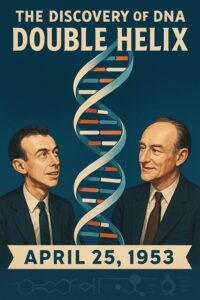On April 25, 1953, James Watson and Francis Crick unveiled one of the most groundbreaking discoveries in the history of science—the double-helix structure of DNA. This revelation unlocked the secret of how genetic information is stored and passed from one generation to the next, forever changing the fields of biology, medicine, and genetics. Their work laid the foundation for modern molecular biology and has since led to advances in genetic engineering, forensic science, and disease research.
The journey to discovering DNA’s structure was a collaborative effort, building on the work of scientists before them. In particular, Rosalind Franklin’s X-ray diffraction images were crucial in revealing the helical nature of DNA. Using her data—without her direct permission—Watson and Crick pieced together the now-famous double-helix model. Their discovery explained how DNA replicates and carries genetic instructions, solving one of biology’s greatest mysteries. However, for decades, Franklin’s contributions were largely overlooked, sparking debates about scientific recognition and ethics.
The impact of their discovery was immediate and profound. Understanding DNA’s structure paved the way for decoding the human genome, cloning, gene therapy, and countless medical breakthroughs. Today, DNA technology is used in everything from diagnosing genetic disorders to solving crimes and tracing ancestry. The study of genetics continues to evolve, offering new possibilities in personalized medicine, agriculture, and even space exploration.
Watson and Crick’s discovery was more than just a scientific milestone—it was a turning point in human understanding of life itself. As research in genetics advances, the double helix remains an enduring symbol of scientific curiosity and innovation. The structure of DNA may have been discovered in a single moment, but its impact will continue shaping the future of science for generations to come.

